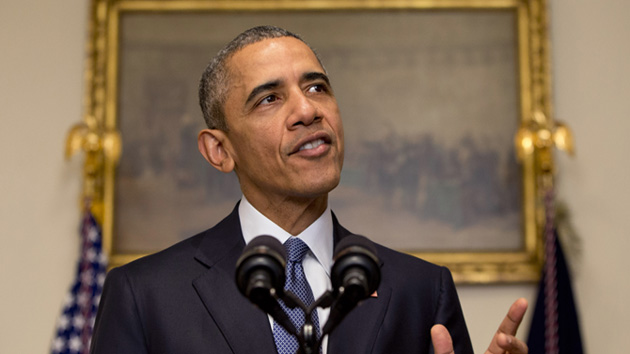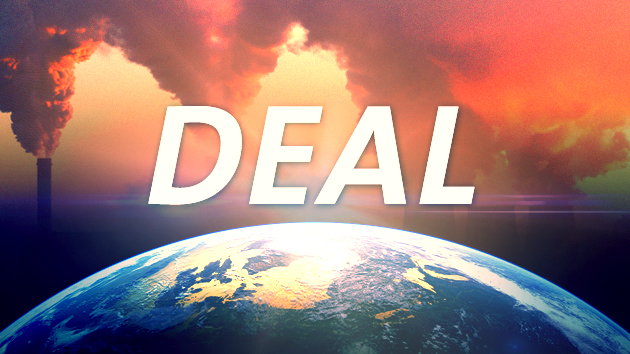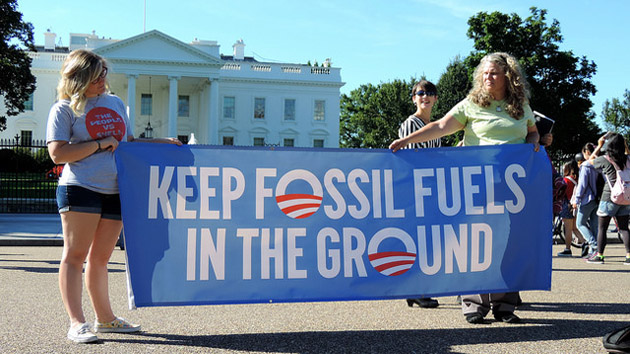The story was originally published by Grist and is reproduced here as part of the Climate Desk collaboration.
The Paris Agreement to address climate change, adopted on Saturday, will be remembered as a big step forward and at the same time a frustrating set of compromises and omissions.
The COP21 conference brought every country to the table, they all accepted the science of climate change, and they agreed to work together to do something about it. But some proved more ambitious than others, and the rich countries didn’t come up with enough money to get the best deal possible.
The bottom line is that the agreement gets us far closer to containing climate change than we were two weeks ago, but still far short of where we need to go. In fact, we won’t even know for years what it will accomplish. How much the agreement reduces greenhouse gas emissions, and through that reduces warming, will depend on whether countries meet their targets for curbing emissions and deploying renewable energy and whether they ramp up their ambition in the years ahead. In terms of climate justice, there is even less to cheer. Rich countries like the United States, Canada, and the European Union upped their pledges for climate finance slightly, but nowhere near enough to compensate for the hugely outsized share of the global carbon budget they have devoured.
Still, the Paris Agreement builds the architecture for greater progress in the next decade. Here is your guide to the basics of what the deal does, what it contains, and what it doesn’t:
So what does it do?
The Paris Agreement commits 196 countries to work together to limit global warming to no more than 2 degrees Celsius (3.6 degrees Fahrenheit) above pre-industrial levels, with a stretch goal of keeping below 1.5 C (2.7 degrees F). It also calls for stopping the rise of greenhouse gas emissions as soon as possible.
Before the Paris conference began, each country submitted an action pledge, known as an Intended Nationally Determined Contribution (INDC), laying out what it will do to curb emissions, increase renewable energy, and/or reduce deforestation. The pledges vary wildly. And there are two very, very big loopholes: The INDC commitments are voluntary, which means there is no penalty for failing to meet them. And even if they are met, they will not put the world on a path to less than 2 C of warming. Under the most optimistic assumptions, the INDCs still set us on a path to 2.7 to 3.5 C of warming. That’s why climate experts like Joe Romm of Think Progress say they are merely buying us more time to take real action. But that’s better than just heading straight off the cliff.
The good news is that the agreement includes a process for strengthening INDCs. In 2018, countries will take stock of their progress on meeting their pledges, and by 2020 they will have to produce new INDCs. They could simply restate the same goals, but the hope is that they will go further as the problem grows more urgent, the political movement for climate action becomes more powerful, and clean technology gets cheaper and more widespread. President Obama, who worked hard for success in Paris, argues that countries will find—as the US has since he took office—that once you start down the path of expanding renewable energy, it’s easier than expected. That’s why the US and its allies in the negotiations made this their top request.
The Paris Agreement is not a treaty, and countries’ INDCs are not binding. (The Obama administration made sure of this so it wouldn’t have to submit the deal to the US Senate for approval.) Still, the deal contains some binding elements, such as requiring countries to participate in a system for measuring their progress on achieving their goals.
What made it into the deal?
- Everyone is involved. Previous agreements put all the responsibility for reducing emissions on rich countries. In the Paris Agreement, all 196 signatories agreed that every country must take action, while acknowledging that richer countries should start immediately and cut emissions more steeply, while poorer countries’ contributions will depend on their individual situations.
- A “ratchet mechanism.” This is the technical term for the agreement to submit new pledges by 2020. It’s the most important victory within the agreement, as many large developing nations, like India and Indonesia, were reluctant to agree to a system that would pressure them to up their ambition within the next decade. Most INDCs set goals through 2030, but if we don’t improve upon them, it will be impossible to stay below 1.5 C and almost impossible to stay below 2 C. The ratchet mechanism requires countries to return to the table in 2020 and spell out their plans for 2025 to 2030. This creates the opportunity for the world to potentially put itself on a course to stay below 2 C, but we won’t know the outcome until 2020 and beyond.
- Small increases in climate finance, including adaptation aid. It was clear from the first day of the conference, as heads of state spoke, that for many developing countries experiencing the effects of climate change, increased aid for adaptation was a top priority. Thus far, most climate finance has been for reducing emissions. And, overall, rich nations have fallen far short of the 2009 goal of providing $100 billion in climate finance per year by 2020. Developed countries—the most generous being Germany, France, the United Kingdom, and the European Union as a whole—made new pledges of several billion dollars each while in Paris. That mostly isn’t earmarked specifically for adaptation, but some of it is. And Secretary of State John Kerry, in an effort to give the negotiations a boost and show developing nations that the US is listening to their concerns, announced on Wednesday that the US would double its adaptation aid from $400 billion to $800 billion over five years. That may have helped get a final agreement, but it’s still a pittance in the context of the US economy, its budget, and its massive historical climate debt.
- Richer developing countries have started contributing to climate finance. Under the original UN Framework Convention on Climate Change, a specific set of developed nations—those who were rich in 1992, when it was first negotiated—were given the general responsibility of paying for climate change mitigation and everyone else was exempted. But some countries left out, like China, Singapore, and South Korea, have enjoyed dramatic economic growth since then. Others, such as Saudi Arabia and other Gulf states, are fabulously wealthy and the worst carbon emitters per capita. Meanwhile, we’ve seen economic collapse and a consequent drop in emissions in former Soviet states in Eastern Europe. It’s silly to say they must pay but richer countries in the Middle East and Asia shouldn’t. At COP21, richer developing nations, in particular China, refused to accept formal responsibility to contribute, but they agreed to do it on a voluntary basis. In fact, China committed $3.1 billion to climate finance between now and 2020, slightly more than the US’s commitment of $3 billion.
- Loss and damage, sort of. When developed countries pledged in 2009 to come up with $100 billion annually in climate finance by 2020, they had two purposes in mind: reducing and preventing emissions, and preparing for the effects of existing and inevitable warming. But as the devastating effects of rising seas and extreme weather have become more visible, developing countries have demanded a third form of assistance: “loss and damage.” They and their allies in global aid and environmental organizations pushed hard in Paris for a separate section of the agreement dealing with loss and damage. They got one, but it did not put rich countries on the hook for past or future climate change-related destruction in poorer countries. In fact, it explicitly states the opposite, saying, “the Agreement does not involve or provide a basis for any liability or compensation.” (The liability argument would be that countries that have grown rich from burning fossil fuels are legally responsible for the effects of climate change.) Instead it merely directs a task force to “develop recommendations for integrated approaches to avert, minimize and address displacement related to the adverse impacts of climate change.”
- Ambitious abstract goals. As the Copenhagen Accord did in 2009, the Paris Agreement includes the goal of keeping warming below 2 degrees C. But at the behest of the most vulnerable countries, such as the small island states, it also goes further, calling for efforts to stay below 1.5 C. It even requests that the Intergovernmental Panel on Climate Change produce a report on how we could stay below 1.5 C. But this is all merely theoretical at this point, since the INDCs aren’t substantial enough to meet either of those goals.
What got left out of the deal?
- Keep it in the ground. The movement to stop fossil fuel extraction has grown dramatically recently, especially in the US. It is transforming climate politics, and yet it was not reflected in any way in the Paris Agreement. The UN approach has been to get countries to offer cuts in emissions and increases in renewable energy deployment, energy efficiency, or carbon sinks, but it has never called for restraining fossil fuel development. It would be satisfied by a country deploying carbon capture and sequestration (CCS) technology to remove the carbon it emits by burning fossil fuels. But environmental, social justice, and human rights activists would not call that adequate (even if CCS technology were widely available and affordable, which it isn’t). Fossil fuel extraction, transportation, and combustion have a host of negative environmental, human rights, and public health impacts aside from climate change. Perhaps next time activists will persuade countries to include limits on domestic fossil fuel extraction in their INDCs. They certainly will try. But the odds will be stacked against them. “Keep it in the ground” is the rallying cry of some of the least powerful people in the world, like indigenous communities. On the other side are fossil fuel corporations with more money than God. Then again, if divestment campaigns—which got some big new pledges in Paris last week—continue to spread, fossil fuel companies might not be quite so powerful five years from now.
- Indigenous rights. A close cousin to “keep it in the ground” language would be language protecting the rights of communities, in particular indigenous communities, from the effects of fossil fuel extraction. Indigenous activists from all over the world came to Paris to advocate for that, but were unsuccessful. Indigenous rights are mentioned in the preamble, but left out entirely of the operational text.
- Sufficiently ambitious national targets. It’s no surprise that INDCs were weak, since countries announced them long before negotiators arrived in Paris. There had been hope that some countries would strengthen their INDCs as part of negotiations. In particular, there were developing countries that had offered a “conditional” track of higher ambition in exchange for more climate finance. But rich countries didn’t pony up enough money to spur any developing countries onto a faster track to a clean energy economy. Virtually no rich countries are giving anywhere near enough to meet their historical obligations, but the US comes in for particular blame. It is giving less, relative to the size of its economy, than less populous countries such as Canada and many European nations. And congressional Republicans are trying to prevent payment of even the minimal amount of funding the U.S. has pledged.
- Decarbonization. The Paris Agreement calls for the world to “achieve a balance between anthropogenic emissions by sources and removals by sinks of greenhouse gases in the second half of this century.” In other words, sometime between 2050 and 2100, we should have net-zero carbon emissions. That’s not the same thing as no carbon emissions. It means that we could still be emitting carbon, but that would be balanced by removing carbon from the atmosphere through carbon sinks like forests or through CCS or other yet-to-be-developed technologies. This is theoretically consistent with a 2 C goal, but more hardcore climate hawks wanted a goal of a carbon-free economy by 2050. In other words, they want an end to fossil fuel use entirely, as quickly as possible. But countries that are completely economically reliant on oil or gas extraction would not agree to this language—for example, Saudi Arabia, which was frequently tagged as the most obstructive country at the talks. And countries with powerful fossil fuel corporations wouldn’t get on board with such language either.
For activists all over the world, the Paris Agreement shows there is still hope for maintaining a livable climate, but there’s a lot more work to be done pushing world governments to meet the challenge.















